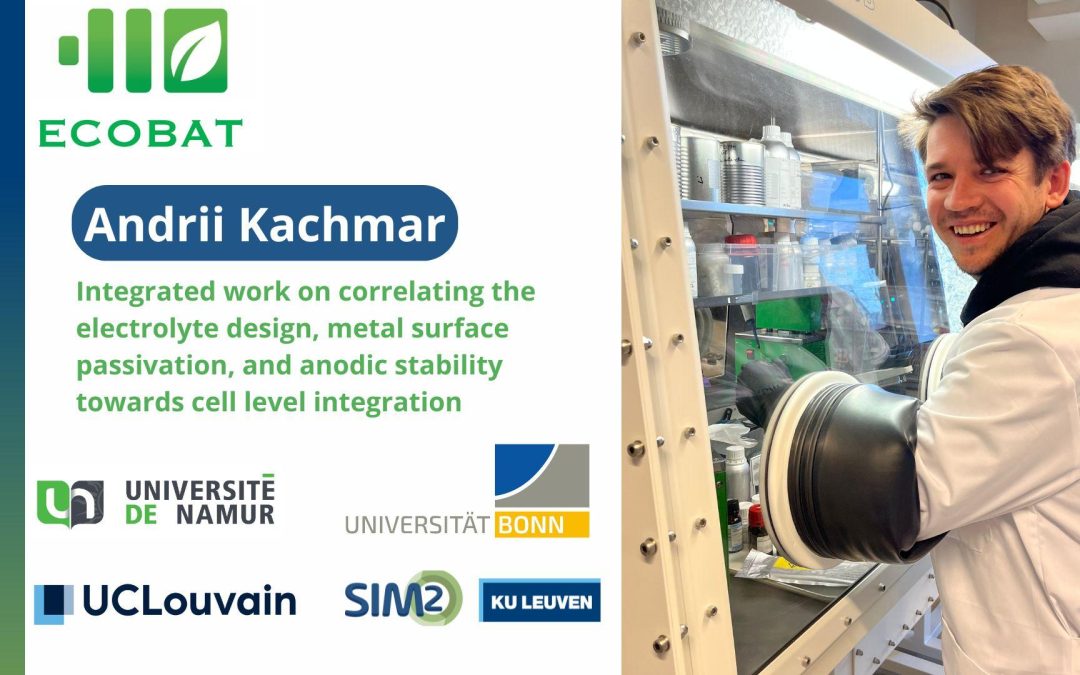Andrii Kachmar is a postdoctoral researcher in the Vlad Energy Group at UC Louvain, focusing on advancing calcium batteries as part of the ECOBAT project. Originally from Ukraine, Andrii earned dual master’s degrees in Physics from Vasyl Stefanyk Precarpathian National University and Ecophysics and Experimental Physics from the University of Rzeszów.
After completing his PhD on supercapacitors at his Ukrainian alma mater, he worked as an assistant professor in Poland, studying electrode/electrolyte interfaces for supercapacitors. In 2022, Andrii joined the Alex Vlad Group at UC Louvain, where he continues his research into cutting-edge battery technologies.
What’s your focus within the ECOBAT project?
I’m working on calcium (Ca) batteries and electrolytes, specifically studying the solid electrolyte interface (SEI) that forms on electrode surfaces. SEI is a thin film that plays a crucial role in battery performance, including its irreversible capacity, cycling performance and service life.
My research aims to understand the structure of SEI and develop new Ca electrolytes that support efficient cycling. I explore these systems experimentally, while my colleague Pierre Beaujean from Professor Benoît Champagne's group from UNamur complements this work with theoretical calculations.
I am actively working with electrolytes to develop or enhance our understanding of calcium-based systems. Our primary focus is on calcium electrolytes due to calcium's superior sustainability, lower environmental impact, and cost-effectiveness compared to lithium. However, calcium presents significant challenges related to electrochemical efficiency and reactivity.
Future plans also include exploring magnesium-based electrolytes as a complementary area of research. Additionally, we are investigating the solid electrolyte interphase (SEI) that forms on calcium surfaces under various conditions. This includes studying the effects of different environments, solvents, and electrolytes to enhance the stability of future calcium batteries. Our goal is to gain a more comprehensive understanding of the mechanisms behind passivation layer formation, which is essential for improving the performance and durability of calcium-based energy storage systems.
What makes a good calcium electrolyte?
A good Ca electrolyte needs to be efficient, sustainable, and cost-effective. Right now, many Ca electrolytes rely on fluorine compounds like Ca[TFSI]₂ or Ca[BF₄]₂ to function, but fluorine is toxic and difficult to recycle.
Our goal is developing an electrolyte that enables over 1,000–2,000 cycles of plating and stripping, works well with various cathode and anode materials, has minimized fluorine content and remains affordable.
What makes you interested in this research project?
Lithium-ion batteries are widely used, but their reliance on lithium—a resource concentrated in specific regions—poses challenges for global supply chains. Moreover, as Li batteries have been well known for decades, there is not much performance growth to be expected. In contrast, calcium is the third most abundant metal in the Earth's crust, making it more readily available and accessible. Although calcium batteries have been studied less, they hold the potential to deliver similar or even superior performance at a lower cost.
I’m excited by the potential to innovate battery science. Together with my colleagues, we’re working to improve Ca batteries, which could one day replace lithium batteries. Working in the Alex Vlad Group is particularly rewarding because of the team’s expertise in electrochemistry, which helps me grow as a scientist and expand my knowledge of chemistry and physics.
How do you see the batteries of the future?
The future of batteries will likely move beyond lithium. I hope to new types of batteries using metals like calcium, magnesium, sodium, or potassium. There’s also potential for exciting innovations, such as batteries without anodes or ones made with organic materials. While lithium batteries are near their peak, these alternative metals could unlock superior performance through advanced electrolyte, cathode, and anode combinations.
Lithium batteries are well-established, and further studies on them may not yield significant improvements in performance. Additionally, lithium deposits are limited and geographically concentrated in specific regions with unique geology, such as Bolivia, Argentina, Chile, and Australia.
Therefore, it is logical to focus on developing batteries based on alternative metals such as calcium, magnesium, sodium, or potassium, which are more abundant, environmentally friendly, and cost-effective.
The future of batteries also holds numerous possibilities, including designs with organic cathodes, metal-free systems, solid-state solutions, and even polymer-based batteries. These innovative approaches could address current limitations and open new avenues for sustainable energy storage technologies.
How do you stay motivated to do research?
I’m motivated by the desire to understand how things work and find ways to improve them. I also enjoy learning new things and exploring fresh ideas.
What activity helps you to fully disconnect?
Reading books science fiction. Recently I read “2001: A Space Odyssey” by Arthur C. Clarke. It’s quite an interesting book that explores humanity's evolution, artificial intelligence, and the mysteries of the cosmos. The story follows a voyage to Jupiter with the sentient, raising profound questions about human existence and our place in the universe.
Additionally, I enjoy staying active, doing sports, and exploring new places.
What do you like in Belgium and what do you miss from your home country?
In Belgium, I appreciate the opportunities for personal and professional growth. It’s not always easy to start a business or find a job here, but it’s possible if you’re determined. That said, I miss the sunshine and real winters of Ukraine. Belgian winters feel endless, and the summers are far too short—just two weeks, it seems!

